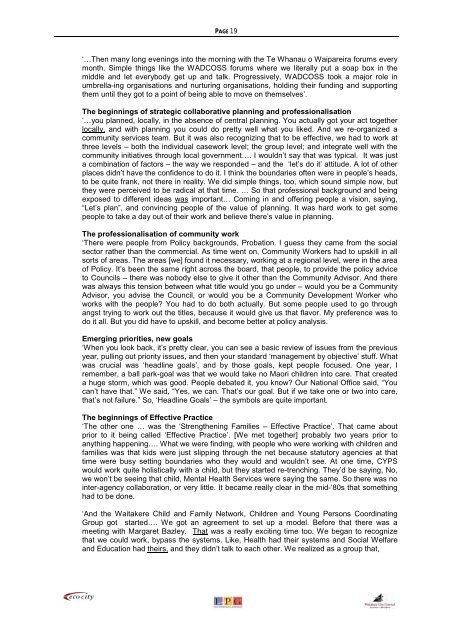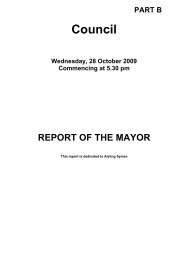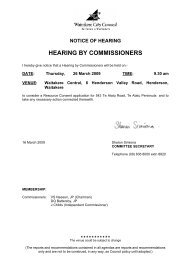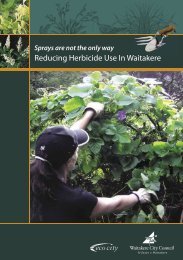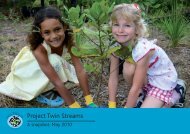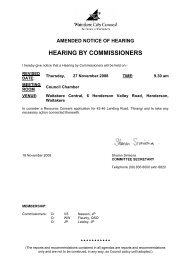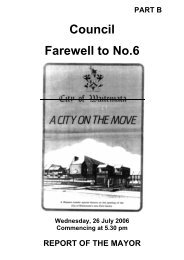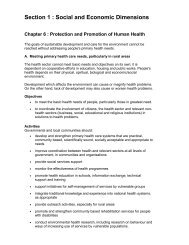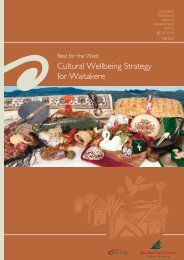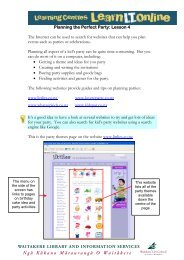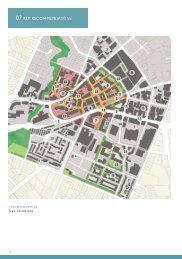The Waitakere Way - Looking Back, Going Forward - Auckland Council
The Waitakere Way - Looking Back, Going Forward - Auckland Council
The Waitakere Way - Looking Back, Going Forward - Auckland Council
You also want an ePaper? Increase the reach of your titles
YUMPU automatically turns print PDFs into web optimized ePapers that Google loves.
PAGE 19‘…<strong>The</strong>n many long evenings into the morning with the Te Whanau o Waipareira forums everymonth. Simple things like the WADCOSS forums where we literally put a soap box in themiddle and let everybody get up and talk. Progressively, WADCOSS took a major role inumbrella-ing organisations and nurturing organisations, holding their funding and supportingthem until they got to a point of being able to move on themselves’.<strong>The</strong> beginnings of strategic collaborative planning and professionalisation‘…you planned, locally, in the absence of central planning. You actually got your act togetherlocally, and with planning you could do pretty well what you liked. And we re-organized acommunity services team. But it was also recognizing that to be effective, we had to work atthree levels – both the individual casework level; the group level; and integrate well with thecommunity initiatives through local government…. I wouldn’t say that was typical. It was justa combination of factors – the way we responded – and the ‘let’s do it’ attitude. A lot of otherplaces didn’t have the confidence to do it. I think the boundaries often were in people’s heads,to be quite frank, not there in reality. We did simple things, too, which sound simple now, butthey were perceived to be radical at that time. … So that professional background and beingexposed to different ideas was important… Coming in and offering people a vision, saying,“Let’s plan”, and convincing people of the value of planning. It was hard work to get somepeople to take a day out of their work and believe there’s value in planning.<strong>The</strong> professionalisation of community work‘<strong>The</strong>re were people from Policy backgrounds, Probation. I guess they came from the socialsector rather than the commercial. As time went on, Community Workers had to upskill in allsorts of areas. <strong>The</strong> areas [we] found it necessary, working at a regional level, were in the areaof Policy. It’s been the same right across the board, that people, to provide the policy adviceto <strong>Council</strong>s – there was nobody else to give it other than the Community Advisor. And therewas always this tension between what title would you go under – would you be a CommunityAdvisor, you advise the <strong>Council</strong>, or would you be a Community Development Worker whoworks with the people? You had to do both actually. But some people used to go throughangst trying to work out the titles, because it would give us that flavor. My preference was todo it all. But you did have to upskill, and become better at policy analysis.Emerging priorities, new goals‘When you look back, it’s pretty clear, you can see a basic review of issues from the previousyear, pulling out priority issues, and then your standard ‘management by objective’ stuff. Whatwas crucial was ‘headline goals’, and by those goals, kept people focused. One year, Iremember, a ball park-goal was that we would take no Maori children into care. That createda huge storm, which was good. People debated it, you know? Our National Office said, “Youcan’t have that.” We said, “Yes, we can. That’s our goal. But if we take one or two into care,that’s not failure.” So, ‘Headline Goals’ – the symbols are quite important.<strong>The</strong> beginnings of Effective Practice‘<strong>The</strong> other one … was the ‘Strengthening Families – Effective Practice’. That came aboutprior to it being called ‘Effective Practice’. [We met together] probably two years prior toanything happening…. What we were finding, with people who were working with children andfamilies was that kids were just slipping through the net because statutory agencies at thattime were busy setting boundaries who they would and wouldn’t see. At one time, CYPSwould work quite holistically with a child, but they started re-trenching. <strong>The</strong>y’d be saying, No,we won’t be seeing that child, Mental Health Services were saying the same. So there was nointer-agency collaboration, or very little. It became really clear in the mid-‘80s that somethinghad to be done.‘And the <strong>Waitakere</strong> Child and Family Network, Children and Young Persons CoordinatingGroup got started…. We got an agreement to set up a model. Before that there was ameeting with Margaret Bazley. That was a really exciting time too. We began to recognizethat we could work, bypass the systems. Like, Health had their systems and Social Welfareand Education had theirs, and they didn’t talk to each other. We realized as a group that,


